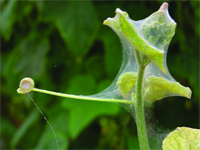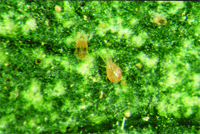
Features
Biocontrols
Inputs
Greenhouse Grower Notes: Sizing up predatory mites
March 14, 2008 By Gillian Ferguson
Which are most effective in controlling two-spotted spider mites?
For decades, the predatory mite, Phytoseiulus persimilis, has been the mainstay of biocontrol programs for the
two-spotted spider mite (Tetranychus urticae). Recently, another predatory mite, Neoseiulus californicus, also known as Amblyseius californicus, has assumed an increasingly important role in biocontrol programs in Ontario greenhouse vegetables, particularly in cucumbers. This crop has notoriously been a challenge regarding successful biocontrol of the two-spotted spider mite, particularly during the hot, dry months of late spring and summer. By capitalizing on the different traits of P. persimilis and N. californicus, success in biocontrol of the spider mite has significantly increased.

|
| Cucumber shoot heavily infested with spider mites. Photo courtesy Gillian Ferguson/OMAFRA |
But, as the saying goes, there is always room for improvement. Thanks to major commercial insectaries, our industry is fortunate to have access to a range of other predatory mites that belong to the mite family known as Phytoseiidae. P. persimilis and N. californicus both belong to this family. Other commercially available predatory mites belonging to this family and that could assist in biocontrol of spider mites include Galendromus occidentalis, Neoseiulus fallacis, Amblyseius andersoni, and Amblyseius swirskii.
So, which of these predatory mites, and in what combination, are the best to use? The quick, short answer to this is – to my knowledge, we’re not certain. Much more research is needed regarding their applicability, particularly under commercial conditions. However, many researchers have carried out intensive studies on these mites and have provided a fair understanding of the characteristics peculiar to many species in the Phytoseiidae family of mites. They have even categorized them using information gathered on their food habits and related biological characteristics.
In 1997, a pair of researchers, J.A. McMurtry and B.A. Croft, from the Universities of California and Oregon, respectively, described four major lifestyles or categories of predatory mites within the Phytoseiids, but only the first three (Types I, II and III) are of relevance to the greenhouse industry at this time. I believe that understanding a bit about these categories could assist us in determining the application of a particular predatory mite in
biocontrol programs.
Type I Category – Predators within this category are specialized predators of Tetranychus species. That is, a Type I predator will only feed specifically on mites belonging to the genus Tetranychus, such as our very familiar two-spotted spider mite. This category is represented only by Phytoseiulus species. Reproduction of Phytoseiulus species seems to depend on use of Tetranychus species as their food or prey. The specialization of Phytoseiulus to Tetranychus species is illustrated by their strong tendency to remain in areas infested with spider mites, and by the fact that they feed, reproduce and carry out all their life functions within spider mite colonies.
Eggs of P. persimilis are mostly laid on the web produced by spider mites, and all the mobile stages can move readily among the web. Furthermore, the tendency of P. persimilis to disperse or move away from infested areas is suppressed as long as live prey or spider mites are present. Type I species are efficient in their consumption of spider mite prey, much more so than the other Types. But this apparently desirable trait backfires because of their inability to exist on alternative foods. That is, P. persimilis populations peter out in the absence of spider mites.
 |
| Predatory mite, Phytoseiulus persimilis, about to attack a two-spotted spider mite. Photo courtesy Gillian Ferguson/OMAFRA |
Type II Category – Predators assigned to this category are usually associated with Tetranychus species or other species that produce dense webbing. They may also feed on other types of mites such as russet and cyclamen mites, and are therefore not as specialized as Type I species. Species included in this category include Galendromus occidentalis, N. californicus and N. fallacis. They generally have lower food requirements for completing development compared to species in Types I and III.
However, differences exist among these predatory mites. For example, the reproductive capacity and develop-
mental rate is classed as medium in Galendromus to high in most species of Neoseiulus. Also, adults of N. fallacis and N. californicus are more active than G. occidentalis and will therefore move more between infested patches or spider mite colonies. In fact, these two species have high powers of aerial dispersal when live spider mites become scarce in their immediate vicinity.
Type III Category – Predators in this category are called generalist predators because they have a much broader food range and feed on various mites species, pollen and insects such as whiteflies, thrips and mealybugs. Species in this category include A. andersoni, A. swirskii, N. barkeri, N. cucumeris and Iphiseius (also known as Amblyseius) degenerans.
Although predators in this category will feed and reproduce on a range of food, all food types are not equally valuable. For example, though A. swirskii will feed and reproduce on various types of spider mites, Tetranychus species, in particular, are considered inferior prey for this predator, and A. andersoni will reproduce more on rust mites than on spider mites. Unlike Types I and II, Type III predators do not associate strongly with spider mite colonies. In fact, fewer
predators in this category are found on leaves with high mite density than on leaves with a low density. Apparently, many species are adversely affected by dense spider mite webbing. Presence of sheltered areas such as depressions on the leaf surface, leaf hairs or other sheltered areas may be more important to them than available food. Within this category, cannibalism and preying on other predators may be more common than in Type I and II specialists.
 |
| Gillian Ferguson, OMAFRA |
IMPLICATION OF CATEGORIES
The highly specialized Type I species are better at efficiently reducing a spider mite infestation, but this same efficiency can cause it to “self-destruct” and allow later infestations to develop. The less specialized Type II, though not as efficient as the Type I specialist, will also aggregate and multiply in spider mite colonies and contribute directly to reduction in spider mite infestations. They also bring with them their high powers of dispersal, their low food requirements, and low tendencies for cannibalism. Some researchers suggest that the generalist Type III could be used as a means of slowing development of spider mite populations, with Type I being released when pest populations begin to increase.
Aside from the traits described in this article, many more factors can contribute to the success of a particular predatory mite in a biocontrol program for spider mites. Factors such as efficiency of response to pest infestations, diet habit of immatures, dispersal ability, tendency towards cannibalism, characteristics of the plant host, behaviour towards other predatory species, environmental conditions, etc., will determine how much a particular predator can contribute to a biocontrol program. As such, much work still needs to be done on an applied or practical scale before we can determine how to optimally manipulate combinations of available predatory mites. Further articles will elaborate on predatory mites for biocontrol of the two-spotted spider mite.
Print this page